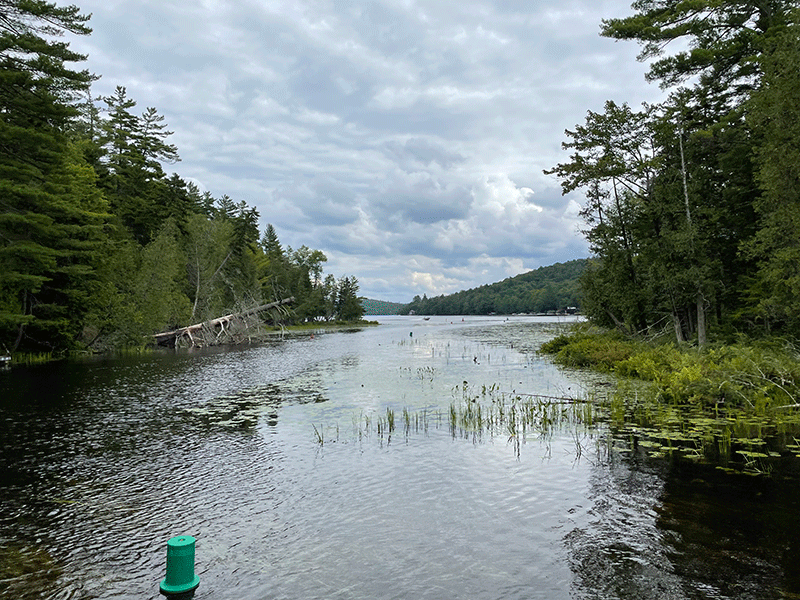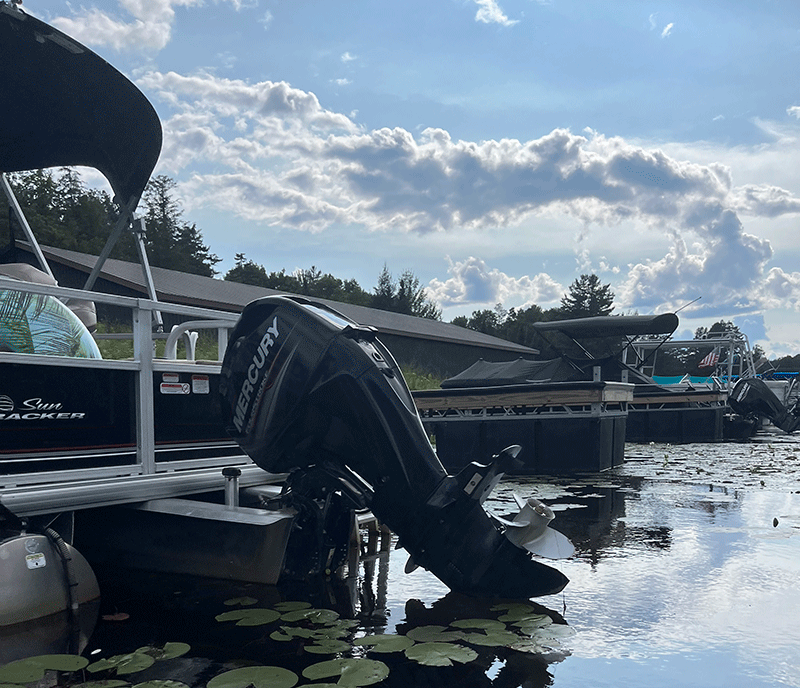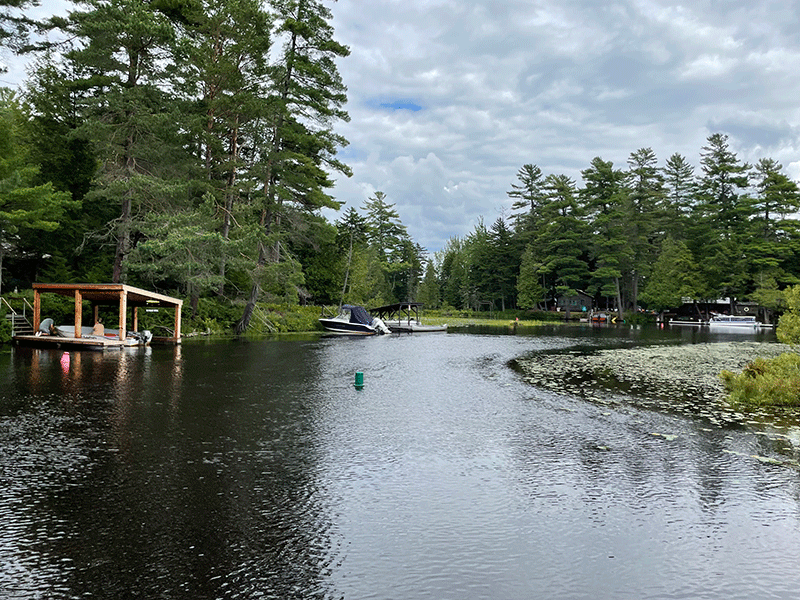Assessing the carrying capacity of specific areas of the public Forest Preserve, especially lakes and ponds, has been a requirement of the Adirondack Park State Land Master Plan for decades. Despite the plain language of the Master Plan, the Department of Environmental Conservation (DEC) has failed to complete any such studies for major lakes and ponds in the Adirondack Park. The Adirondack Park Agency (APA) has never pushed the DEC to complete these analyses, nor undertaken any on its own. This Master Plan requirement has been openly flaunted by both agencies.
The Master Plan is clear that carrying capacity analyses are required for Adirondack lakes and ponds, stating this within its opening few paragraphs:
A comprehensive study of Adirondack lakes and ponds should be conducted by the Department of Environmental Conservation to determine each water body’s capacity to withstand various uses, particularly motorized uses and to maintain and enhance its biological, natural and aesthetic qualities. First emphasis should be given to major lakes and ponds totally surrounded by state land and to those on which state intensive use facilities exist or may be proposed. The importance of the quality of these resources cannot be overemphasized. (p.4)
Despite a highlighted importance in the Master Plan that cannot be “overemphasized” the DEC has refused to get serious about these studies. In recent decades, the DEC has made fitful attempts and some false starts but was never able to finish the job. Most recently, in 2011, Adirondack Park Forest Preserve Carrying Capacity of Water Bodies Study, Phase 1, was requested by and delivered to the DEC. For the past dozen years, that report has been available to inform the DEC and the APA about how to proceed with this necessary and legally mandated carrying capacity study and evaluation.
Carrying capacity studies should be a cornerstone of Forest Preserve management. “Carrying capacity” means the ability of natural resources to withstand and sustain human activity and the environmental impacts resulting from those activities. In the case of waterbodies it means the impacts on water quality, fish and wildlife, scenic and aesthetic resources, and the user experience resulting from increasing boat traffic and potentially conflicting visitor use. A carrying capacity study would examine these factors, evaluate whether and to what extent the carrying capacity has been exceeded, and recommend measures to avoid exceeding the carrying capacity and/or to return resources to an acceptable level that does not exceed the carrying capacity.
The Saranac Chain of Lakes has long been one of the most popular and heavily used networks of lakes and ponds in the Adirondacks. These lakes are intermixed with private lands and camps and extensive Forest Preserve holdings, where public access to the lakes and dozens of campsites is facilitated by major public boat launches and private marinas. Most of the Forest Preserve in this area is managed through the Saranac Lake Wild Forest Unit Management Plan (UMP). From the Saranac River to Upper Saranac Lake and linked waterbodies the Saranac Chain of Lakes covers over 9,000 acres. Upper Saranac Lake is the fifth largest lake in the Adirondack Park, Lower Saranac Lake is number 18, Middle Saranac Lake ranks 24th, and Oseetah Lake is 32nd. These lakes link to Lake Flower, Kiwassa Lake, Weller Pond, Little Weller Pond, and the Fish Creek Ponds, among others. State facilities include boat launches and the immensely popular Fish Creek and the Saranac Lake Islands Campgrounds.
The Master Plan calls for carrying capacity for “major” lakes. The Saranac Chain certainly meets that test. The Master Plan calls for carrying capacity analysis on state lands on which state intensive use facilities exist. The busy boat launches and the Fish Creek Campground certainly meet that test too.
The Master Plan goes on to provide guidance for APA and DEC, stating: “The physical, biological and social carrying capacity of the water body or other water bodies accessible from the site will not be exceeded.” (p 40) The Master Plan requires that every UMP “contain . . . an assessment of the physical, biological and social carrying capacity of the area with particular attention to portions of the area threatened by overuse,” (p 10-11) which should be prepared by the DEC. Based on information and finding from an analysis of carrying capacity, the UMP must include “the regulation or limitation of public use such that the carrying capacity of the area is not exceeded . . . .” (p 10-11)
For lands and waters classified as Wild Forest, such as the Saranac Lake Wild Forest Area (SLWF), the Master Plan specifies that access to waterbodies can be provided only if the “physical, biological and social carrying capacity of the water body or other water bodies accessible from the site will not be exceeded.” (p 40) Significantly, the Master Plan does not differentiate between waterbodies wholly surrounded by public land and those that include private lands on the shoreline; nor does it absolve DEC and APA from the obligation to consider carrying capacity for waterbodies, such as the waters in the Saranac Lake complex of lakes, that are the subject of a UMP and include private ownership along the shoreline.
Though long required under the Master Plan, the DEC has refused to prepare these studies and the APA has never held the department accountable.
The decision in the recent lawsuit that overturned an APA permit for an expanded marina on Lower Saranac Lake, Thomas Jorling vs Adirondack Park Agency, New York State Department of Environmental Conservation, and LS Marina, LLC, 214 AD3d 98 (3d Dept. 2023), addressed the need for carrying capacity studies. The decision stated that it was truly “inexplicable” that such a study has not been prepared before now for Lower Saranac Lake. A carrying capacity study is critical to analyzing impacts to recreational users, water quality, fish and wildlife, invasive species, and noise levels from the increased motorboat traffic associated with projects subject to APA review. A carrying capacity analysis is clearly merited on Lower Saranac Lake.
Though the DEC failed to undertake a carrying capacity analysis on Lower Saranac Lake, and the APA failed to require one during its recent review of the major marina expansion there, we now face these same issues to an even greater degree on Upper Saranac Lake and the Fish Creek Pond where another major marina expansion is proposed. The number of businesses and private camps on Upper Saranac Lake, many of which are boat access only, along with the array of Forest Preserve lands on the shoreline, and major facilities like the Fish Creek Campground, demand the completion of a long-overdue carrying capacity study for the Saranac Lake Wild Forest and Fish Creek Campground Intensive Use Area.
The site of the proposed marina on Lower Fish Creek Pond is located in the Town of Santa Clara, Franklin County. This pond is connected to Square, Follensby Clear and Little Square ponds, and to Upper Saranac Lake.
As mentioned earlier, the Saranac Lake Wild Forest (“SLWF”) UMP governs the lakes and ponds throughout the Saranac Chain. These waterbodies are heavily used by boats, which have environmental and social impacts. The SLWF UMP recognized the importance of boating, stating:
There are several ways that water quality is impacted: introduction of nutrients, petroleum products, effluent, sediment, and invasive species; damage to riparian vegetation; and disturbances to bird nesting are pressures and impacts on water bodies from use . . . In addition to the environmental impacts, there are also impacts to the recreational experience caused by use on water bodies. Crowding and conflict impact one’s experience on a waterbody. (SWLF UMP p 111)
The SLWF UMP further explains that motorboats “have the potential to cause a greater variety and more significant impacts than non-motorized watercraft.” (p 75) To address these impacts, the SLWF UMP identifies the need for “a comprehensive [carrying capacity] study” of the waterbodies in the Saranac Lakes Complex. (p 112)

These two pictures show the channel between Upper Saranac Lake and the Fish Creek Ponds. This channel isn heavily travelled by motorboats and canoes and kayaks. A major marina expansion will put more boats on this channel, yet DEC and APA have never undertaken a Carrying Capacity Study.
The Master Plan clearly calls for a carrying capacity study for the Saranac Chain of Lakes and the SLWF UMP explicitly calls for a carrying capacity study. Surely, as part of the APA’s review of a proposed expansion of the former Hickock’s Marina on Lower Fish Creek Pond, given the narrow channels and undeniable high boat traffic in that area, a carrying capacity study is needed. Yet, we hear only crickets on this matter from the APA and DEC, neither of which it seems can muster the leadership to tackle this issue despite clear legal requirements that they do so.
The SLWF UMP recognizes that the Saranac Lakes Complex in the vicinity of the marina project site is already experiencing substantial increases in boat traffic. For example, between 2014 and 2017 the number of boats using the Fish Creek boat launch increased by more than a factor of ten, from 164 to 1,947 boats. (p. 59 Table 8) Between 2001 and 2017, the number of boats counted at the Upper Saranac Lake boat launch increased by more than 40 percent, from 1,204 to 1,713. The proposal to add even more motorboats to an already overburdened system of lakes and ponds must be evaluated in the context of the carrying capacity of those waterbodies.
The fact that the project is on private lands does not relieve the APA of the obligation to consider the project’s effects on the State-owned waterbodies that are part of the SLWF. As stated in the UMP:
The SLWF cannot be considered without recognizing the uses of adjacent lands. The character of the surrounding lands and what occurs on those lands impacts the SLWF, just as the SLWF has an impact on the lands that surround it. Private lands can affect the environmental condition of the SLWF, the management actions which the State needs to take, public use, and public interest in the area. (p 61)
The SLWF UMP explicitly recognizes that activities on adjacent private lands can affect the quality of public lands and waters:
There are developed private lands directly adjacent to many parcels of the SLWF. The more developed this adjacent private land is, the greater impact on the SLWF. Human impacts extend beyond any development . . . The adjacent developed private land also impacts recreational activities. Those areas of the SLWF in close proximity to developed private property become unusable or undesirable for activities such as hunting and camping . . . . Future developments on private property near the lands of the SLWF can increase the impacts to the unit. (p 62)
In fact, the APA Chairman John Ernst, recently emphasized the interconnectedness of public and private lands in the Adirondacks, saying in a statement from May 2023 that “The greatness of the Adirondack Park is fundamentally rooted in the interdependence of the public and private regional land use plans.” The Chairman’s statement is an important affirmation by the APA about the interconnectedness and mutual dependence between the private lands and the public Forest Preserve in the Adirondack Park. This interconnectedness requires that potential impacts from a major private land development on the Forest Preserve must be evaluated with carrying capacity studies.
For too long the APA and DEC have ignored the plain language of the Master Plan and tuned out commitments made in UMPs to undertake carrying capacity analysis. The DEC is working with OTAK, a consulting group, to develop a Visitor Use Management pilot plan for the central High Peaks Wilderness. A perfect complement to that planning effort would be a carrying capacity analysis on the Saranac Chain of Lakes.







